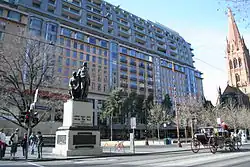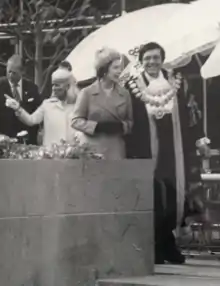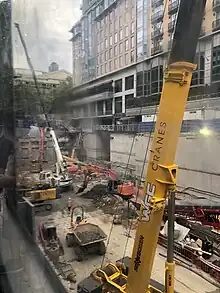City Square, Melbourne
The City Square was a public plaza located in the Central Business District (CBD) of Melbourne, Victoria, Australia. The site was bounded by Swanston Street, Collins Street, Flinders Lane and the Westin Hotel. The historic landmarks of Melbourne Town Hall and St Paul’s Cathedral were across the streets to the north and south respectively.
| City Square | |
|---|---|
 City Square looking from Swanston Street before its demolition | |
| Type | Public space |
| Location | Melbourne, Australia |
| Coordinates | 37°48′57″S 144°58′1.3″E |
| Opened | 28 May 1980 |
| Closed | 3 April 2017 |
| Designer | Denton Corker Marshall |
| Public transit access | |
The square was redeveloped several times and associated with a number of controversies over the years. It closed on 3 April 2017 in preparation for the construction of Town Hall station as part of the Metro Tunnel project, and was demolished later that year.[1] The square is set to be restored following the completion of the tunnel in 2025.
History
The Melbourne CBD was originally laid out by Robert Hoddle in 1837 as a rectangular grid of 8 x 4 city blocks, with open space reserved around the edges. Like most other early Australian town layouts it lacked any kind of civic or open space within the grid, but reserved blocks or allotments for markets, public buildings, and churches. This lack of any public space or sweeping boulevards was criticised as early as 1850, and proposals for public squares within the grid cropped up regularly from the 1850s to the 1950s.[2]
Council takes action
When Sir Bernard Evans, architect and city councillor, was Lord Mayor of Melbourne in 1961, he was firmly of the view that a city square should be created between the town hall and the cathedral, instead of a civic plaza with a new town hall on top of the rail yards opposite Flinders Street Station, or a space to the north or east of the town hall; but he could not convince his fellow councillors.[3] In 1966, when the Queen Victoria Building (on the corner of Swanston and Collins streets) and the adjacent City Club Hotel (opposite the town hall) had been demolished by a developer pending future development, Council finally decided that it was a good site for the long debated City Square, and purchased the land.[4][5][6][7]
Then began the process of acquiring properties along Swanston Street between the town hall and the cathedral, and east up to an including the Regent Theatre. Buildings purchased included the Cathedral Hotel, Cathedral House, Guy's Buildings (demolished 1969), Green's Building and the Town Hall Chambers (demolished 1971) as well as Wentworth House and Regency House on Flinders Lane.[8] After the Regent Theatre closed in 1970, Council bought that too, intending to demolish it for a larger square and a hotel tower to help fund the whole project, but it was saved by a union ban imposed in 1974.[9]
By 1968, a temporary square of grass and paving was installed on the site of the Victoria Building and City Club Hotel, extended by the early 1970s up to Flinders Lane, then east up to Regent Place. In February 1976, a performance by the band AC/DC was filmed there for a video clip for the single "It's a Long Way to the Top (If You Wanna Rock 'n' Roll)".[10] The video was filmed on the same day as the well-known version filmed on the back of a flatbed truck travelling down Swanston Street.[11]
Permanent square

In 1976, an architectural competition was launched by Melbourne City Council to design a permanent square, which was won by Denton Corker Marshall architects. The design, responding to the complex brief, included a giant video screen, restaurants, shops and outdoor cafes, connected by a glazed canopy, a sunken amphitheatre, graffiti wall, reflecting pool, water wall and cascades as well as the open area of the main square. Most of the elements and the large flat area were clad with sawn bluestone. The Burke and Wills statue (1864) by Charles Summers, which had originally been at the intersection of Collins and Russell streets, was positioned (somewhat ironically) on top of the cascades.
Following its opening by Queen Elizabeth II on 28 May 1980, the new square attracted criticism from the general public.[12] The Age newspaper reported, "in interviews with newspaper reporters and on talk-back radio, many Melburnians have blasted their long awaited City Square for what they see as its bareness, the noise from its controversial video matrix screen and the starkness of the glazed steel canopy running along the Regent Theatre Wall".[13] A large yellow steel sculpture titled Vault by Ron Robertson-Swann, which was commissioned as a centrepiece for the square, was relocated to Batman Park in July 1981 following heated public debate.[14][15]
.jpg.webp)
On 14 January 1981, a 12-year-old boy swimming in the water fountain pool was sucked inside the fountain's filter system and was presumed drowned. Despite being trapped for more than 40 minutes, firemen managed to rescue the boy against the odds.[16]
In the following decade, the square was increasingly seen as a failure.[17]
Second square
In the mid-1990s, the eastern half of the square was sold to developer David Marriner for the development of the Westin Hotel, in a complex deal that saw the restoration of the Regent Theatre, to be managed by Marriner's company Staged Developments.[17] The restored theatre reopened in 1996.[18] Between 1997 and 2000, the remaining area of the square was redeveloped with a much simpler plan, with bars and cafes under the hotel, some seating and the large oak tree transplanted to the Collins Street corner, and a large flat area of granitic gravel intended for events, plus a 450-space carpark underneath.[19][17] A long linear water feature by glass artist Denise Sullivan along the east side, and a water wall known as the John Mockridge Fountain on Collins Street were installed, and plane trees lined the Swanston Street edge.[20][19]

A cast bronze statue of a small dog created by Melbourne artist Pamela Irving and titled Larry La Trobe was located in the north-west corner in 1992. The statue became widely known after its theft in 1995; following a long public campaign, a revamped version of the statue was recast and reinstalled in 1996.[21] In 2003, raised grassed areas were added to soften the space and provide informal seating areas.[22] With the substantial reduction of its area and the opening of the nearby Federation Square soon after in 2002, the civic importance of the City Square was diminished.
In October 2011, Lord Mayor Robert Doyle ordered an eviction of about 100 Occupy Melbourne protesters from the City Square, which was enforced by up to 400 riot police.[23]
Current status

In early 2016, as part of the construction of the Metro Tunnel, it was announced that the City Square would be acquired and demolished to allow for the construction of CBD South station, to be known as Town Hall station. City Square businesses were evicted and the square itself was closed on 3 April 2017, and demolition of the square and the part of the car park structure under it began in late 2017.[24] A large acoustic shed was erected on the site in 2019 to contain construction noise and dust, and remained in place until it was taken down over six months in 2022 by two 50-metre cranes.[25][26] A mural by local artist Emma Coulter titled Spatial deconstruction #23 (resilience) was painted onto the shed in 2021.[26]
As part of the construction of Town Hall station, the City Square precinct is set to be rebuilt as a public gathering and events space.[27] Draft designs for its reconstruction show the square rebuilt much as it was, but with an entrance to the new station occupying the north end.[1] The City Square entrance will be the main entrance to Town Halls station and will feature a glass canopy designed by the Metro Tunnel architects RSHP, Hassell and Weston Williamson.[28]
The famous statue of ill-fated explorers Burke and Wills was removed from City Square in 2017 and is planned to return to the corner of Collins and Swanston Streets after the completion of the station.[29] The John Mockridge Fountain water wall will also be returned and relocated to the northern edge of City Square along Collins Street.[30]
References
- "City Square". Melbourne Metro Rail Project. Archived from the original on 7 May 2017. Retrieved 7 May 2017.
- "City Square". Encyclopedia of Melbourne. School of Historical & Philosophical Studies, The University of Melbourne.
- "Melbourne Town Hall not to be Moved for City Square". Canberra Times. 15 August 1961. Retrieved 28 May 2017.
- "IN VICTORIA THIS WEEK £lm. Paid For A City Corner". Canberra Times (ACT : 1926 - 1995). 30 July 1963. p. 2. Retrieved 19 August 2021.
- "(view of vacant site)". Canberra Times. 4 July 1966. Retrieved 28 May 2017.
- "City Square Approval". Canberra Times. 5 June 1966. Retrieved 28 May 2017.
- Staff Writers (3 July 2019). "From the Archives, 1966: Melbourne Council purchases land for City Square". The Age. Retrieved 21 May 2021.
- Annear, Robin (2005). A City Lost and Found. Melbourne: Black Inc. pp. Chapter 12.
- "Square to get bigger but problems remain". The Age. Melbourne. 3 September 1974. Retrieved 26 December 2011.
- Johnston, Chris (23 February 2006). "AC/DC still current 30 years on". The Age. Melbourne. Retrieved 17 March 2010.
- Donovan, Patrick (13 February 2010). "For a piper, it's a long way to the top from the back of a flatbed truck". The Age. Melbourne. Retrieved 17 March 2010.
- School of Historical Studies, Department of History. "City Square - Entry - eMelbourne - The Encyclopedia of Melbourne Online". www.emelbourne.net.au. Retrieved 26 March 2022.
- The Age. 4 June 1982. p. 3.
{{cite news}}: Missing or empty|title=(help) - Larkin, John (14 July 1981). "Shedding light on that move". The Age. Melbourne. Retrieved 26 December 2011.
- Attwood, Alan (19 June 2004). "Peril in the Square: The Sculpture that Challenged a City". The Age. Melbourne. Retrieved 17 March 2010.
- https://www.newspapers.com/newspage/121251894/
- Reed, Dimity (6 October 2011). "Melbourne's City Square". ArchitectureAU. Retrieved 28 November 2022.
- "Melbourne Central City, Victoria". Australian Places. Monash University. Archived from the original on 10 October 2004.
- "City Square". City of Melbourne. Archived from the original on 26 July 2008. Retrieved 17 March 2010.
- "Monuments Australia". Monument Australia. 19 June 2013. Retrieved 28 July 2016.
- Lucas, Clay (20 August 2006). "The city gets another dead white bloke". The Age. Melbourne. Retrieved 17 March 2010.
- "City Square grassing project". City of Melbourne. Archived from the original on 19 September 2006. Retrieved 17 March 2010.
- Levy, Megan; Preiss, Benjamin (21 October 2001). "Protesters arrested as chaos descends on CBD". The Age. Melbourne. Retrieved 26 December 2011.
- "City Square Closed As Major Metro Tunnel Works Ramp Up". Premier of Victoria. 3 April 2017. Retrieved 27 October 2023.
- Preiss, Benjamin (3 April 2017). "City Square shuts down as work begins on Metro Tunnel". The Age. Archived from the original on 24 June 2018. Retrieved 24 June 2018.
- "City Square acoustic shed to come down". www.cbdnews.com.au. Retrieved 27 October 2023.
- Build, Victoria’s Big (11 May 2023). "Work on Town Hall Station powers ahead under City Square". Victoria’s Big Build. Retrieved 14 June 2023.
- "Updated Melbourne Metro Tunnel station design unveiled". Architecture Australia. 10 August 2021.
- "Melbourne's oldest public statue removed from display". ABC News. 9 April 2017. Retrieved 14 June 2023.
- "CBD South Precinct Development Plan" (PDF). Metro Tunnel Authority: Cross Yarra Partnership. 3 August 2022.
- Day N. (1976), "The Struggle to Build a City Square . . ." Architecture Australia, 65 (4) pp 22–39
- The Age, Melbourne, 4 June 1980:3
- Melbourne City Council - City Square